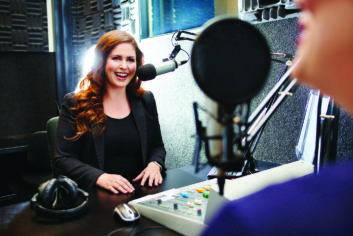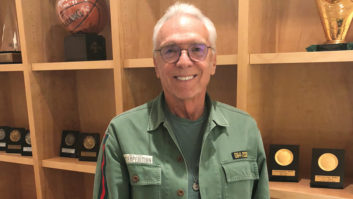
Talk about being hidden in plain sight. It’s an industry with a potential valuation that some put at a billion dollars, with a spike in growth predicted at 110% in 2020, and a growing library numbering nearly 800,000 titles.
And yet many broadcasters have not yet begun to embrace the medium of podcasting — perhaps waylaid by concerns over content creation, monetization or the way in which podcasting may disrupt today’s radio ecosystem.
Podcasting may be poised for even more of an upswing and will make its presence known at April’s NAB Show.
“The podcasting genre is growing, and there is great content being created,” said Chris Brown, executive vice president of business operations for NAB.
“It’s another important form of storytelling that needs to be part of our broad-based show. And momentum is strong for podcasting, so much so that we have already seen examples of podcasting personalities and content even migrating to television.”
EMBRACE DELIVERY
Some broadcasters may view podcasting a bit warily.
Steven Goldstein, CEO of Amplifi Media, will speak at the “The Exploding Business of Podcasting” session. He said many radio broadcasters seem stymied by fear that podcasts might disrupt the radio ecosystem.
“But today there is an expectation that content be available on-demand,” he said. “Broadcasters need to get beyond fear and embrace the delivery of content on other platforms. It’s early days on the money side, but not so different than the early days of the Internet or cable. In two years, it’s probably close to a billion-dollar business.”
When it comes to finding an audience, he said, radio has a megaphone, “a built-in toolset to promote podcasts.”
At the 2019 NAB Show, the convention will address podcasting through live shows, a new Podcasting Pavilion and a series of sessions as a way to showcase the popularity and respect that this medium has garnered.
Jennifer Lane, audio industry expert at the Interactive Advertising Bureau, said that podcasting has grown into a popular form of digital audio in part because it attracts listeners due to its diverse and high-quality content — and the fact that you can listen to it anywhere.
[Seven Myths Broadcasters Believe About Podcasting]
Given these fundamentals, experts say, broadcasters should consider key differences between broadcasting and podcasting. Though they are similar and use some of the same skills, they are different mediums, said Seth Resler with Jacobs Media.
“What works in one may not work in the other,” said Resler, who will speak at the session “Radio Engage: Branded Podcasts — an Alternative Revenue Stream for Radio Stations” at the show.
How are they different?
“From an air talent’s point of view, this means that the ability to do a great job front-selling an Ariana Grande song doesn’t mean that you’re ready to host ‘Serial,’” he said. “From a salesperson’s perspective, it means that selling 60-second produced spots based on AQH and TSL is not the same thing as selling dynamically inserted live reads based on download numbers.
“There’s a learning curve,” Resler said, “and radio broadcasters who are serious about the medium should give themselves the room to figure it out.”
RESOURCE ISSUE
If there’s one thing holding broadcasters back, it’s a lack of time and resources, Resler said.
“This, of course, is a recurring theme in the radio world. As an industry, we tend to be unwilling to allocate resources to anything that doesn’t provide an immediate payoff. I think podcasting is a long-term play for everybody involved, which doesn’t always work with our short-term revenue goals.”
So what are effective podcasters doing today? The successful ones are appealing to underserved niches, whether it be crime, comedy, daily news or fantasy sports, said Goldstein.
He said time-shifted content is a good place for radio managers to start if they are looking to make the most of this platform. “The average morning show listener misses 80 percent of a morning show’s content,” he said. “So the potential to harvest additional listening is pretty appealing. But the real win is extending the brand with original content.”
The single biggest thing that delineates a successful podcaster from a mediocre one is quality, said Dan Franks, president of the podcast conference organization Podcast Movement.
“Podcasters have learned that although technology has made it easier to just create a podcast, the successful ones have learned that quality of content and audio is still king,” said Franks, who will be speaking at the session “How to Grow, and Keep, an Audience for Your Podcast.”
[Survey Says AM-FM Radio Continues to Dominate In-Car Media]
“The podcasts that see the most success are the ones that are not only well-thought-out when it comes to formatting the content of the show, but also show care in the production quality as well.”
It’s also important that radio managers keep this reality in mind: Podcast listeners love it, in part, because it’s different from radio, he said.
“Not only in the way it is consumed, but also in the content itself,” Franks said. “Very rarely do we see radio shows simply repurposed into podcasts become successful. The shows we see received the best are ones that contain completely new content, whether it be an extension of a daily radio show, or a completely new show altogether.”
At NAB Show, sessions will introduce radio managers to some newer players in podcasting including Pandora, iHeart and Luminary, the latter of which recently told the New York Times that it is working to become “synonymous with podcasting in the same way Netflix has become synonymous with streaming.” The session will also check on industry veterans like Blubrry, Libsyn and Spreaker.
The expanded Podcast Pavilion at NAB will also house an “Ask the Expert Area” that will offer insights from professionals on audio production, content, marketing, audience growth and monetization.
SPOTIFY
And how does the recent entry of Spotify change the podcasting landscape? The platform is currently offering listeners thousands of browsable podcast options, some with third-party ads integrated within individual episodes.
“The Spotify move is really interesting,” Goldstein said. “Behind Apple, which dominates podcasting, Spotify is already the second most popular platform to listen to. Their bet is more original content will increase podcast listening.
“That’s good for them two ways,” he said. “First, podcast listeners spend twice the amount of time on Spotify as music-only listeners; second, that [can] happen without expensive music royalty payments.”
Franks said that Spotify may help boost one of podcasting’s long-standing issues: lack of awareness, even after its recent impressive growth.
“Spotify is a place that already has millions of active users currently listening to audio on a daily basis who might not know what a podcast is, or at the very least are not regular podcast listeners,” Franks said. “With Spotify’s new focus on podcasts, they will now be helping to expose podcasting as a medium to those listeners.”
Other areas helping to drive increased consumption of digital audio programs like podcasting include connected cars, which Lane from the IAB said are a big factor in driving expanded listening.
“Apple CarPlay, Android Auto and Bluetooth systems have made it easy to connect and listen in the car,” she said. “In fact, 44 percent connect their phones to their car audio system to listen online. This in-car connectivity creates excellent options for advertisers looking to interact with consumers while they are in the car.”
Lane will talk about that issue at the NAB Show session “Inside the Podcast Ad Space.” Other sessions like “Branded Podcasts — An Alternative Revenue Stream for Radio Stations” and “How Successful Podcasters Break Through” are designed to give broadcasters a closer look at what the medium has in store and how radio can jump into the space.
“What I love about the business is the innovation and trial,” added Goldstein. “It’s all dynamically unfolding in real time.”










